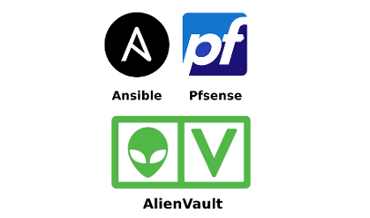Automated Response With Alien Vault Alerts
AlienVault OSSIM generates various alarms, it’s possible that the analyst would miss some of the alarms that could have a devastating impact on our infrastructure. To cater for this scenario, we developed a system for automated response to ensure that alarms against our critical systems are dealt with promptly and effectively.
AlienVault Configuration
We configured AlienVault (SIEM – OSSIM) for continuous monitoring of our internal network and connected devices. AlienVault is fully operational and generates alarms based on the directives/rules that we have created and customised according to our needs.
AlienVault allows us to create custom policies and allows the administrator to trigger one or more of the following actions against those policies:
- Open a ticket.
- Send an email.
- Run scripts
As we have various policies that require different actions, we opted for the third option of running custom scripts to ensure that the policy serves its purposed in an efficient manner.

By default, AlienVault executes a script from its root directory, so we placed our script in the root director, we can pass along all the above-mentioned keywords as parameters for the script.It is important to know if you want to have the script in a directory other than root, you need to set the path relative to the root directory. This information is not present in the official AlienVault documentation and it can cause errors. In our case, we passed SRC_IP, DST_IP and DST_PORT as arguments for our script.

The above figure shows different components of our automated response system.
To get a better understanding of this architecture let us consider a scenario.
Scenario
Lets say we have a server with SSH. This server is added in our AlienVault as one of the assets and hence it is being monitored 24/7. We have written a directive in our AlienVault which triggers an alarm whenever three or more failed login attempts occur on the server. There is a policy defined in AlienVault that gets triggered based on this directive. As mentioned earlier, policies can have various responses. In this case, we will be executing a custom script that will block the IP from which the server has received the failed login attempts by adding the rules in PFSense Firewall by the help of Ansible server and its Playbook. This response will ensure that the adversary attacking our system gets blocked and hence securing our server.
AlienVault OSSIM is an open-source security information and event management system, integrating a selection of tools designed to aid network administrators in computer security, intrusion detection and prevention.
Ansible is an open-source automation tool, or platform, used for IT tasks such as configuration management, application deployment, intraservice orchestration and provisioning.
pfSense is a free and open-source firewall and router that also features unified threat management, load balancing, multi WAN, and more[ii]
AlienVault triggers a script in response to policies which then calls ansible server and add a rule in PFsense [iii]
Internal working of the system
ssh_anomaly.sh
The first script which in AlienVault that gets triggered in response to policy action is ssh_anomaly.sh, this script takes source IP, destination IP and destination port as parameters and calls Ansible server.
#!/bin/bash ## GET Params from AlienVault source_ip=$1 destination_ip=$2 destination_port=$3 ## These are the params of PFsense firewall and can be provided with default value or change according to need interface="wan" type='block' ipproto='inet' description="blocked for ssh anomaly" ## add ssh password of server where ansible-playbook will be executed export SSHPASS="YOUR_ANSIBLE_PASS" ## Execute script on remote server which will execute ansible-playbook with given params sshpass -e ssh username@ANSIBLE_IP "sh YOUR_SCRIPT_PATH_ON_ANSIBLE_SERVER/add_rule.sh $source_ip $destination_ip $destination_port $interface $type $ipproto $description"
Add_rule.sh
This is the script that gets triggered from AlienVault and passes along the parameters needed for firewall rule to Ansible-Playbook
#!/bin/sh # Params will be received from another server via ssh call (from AlienVault) source_ip=$1 destination_ip=$2 destination_port=$3 interface=$4 type=$5 ipproto=$6 description=$7 MY_PID=$$ # Ansible ping ansible -i INVENTORY_PATH/inventory -m ping myhosts # Execute ansible-playbook with given params to add a rule in firewall # Executes playbook.yml ansible-playbook -i INVENTORY_PATH/inventory PLAYBOOK_PATH/playbook.yml --user=ANSIBLE_USER --extra-vars "ansible_sudo_pass=ANSIBLE_PASSWORD" --extra-var type="$type" --extra-var ipproto="$ipproto" --extra-var description="$description" --extra-var sourceip="$source_ip" --extra-var destinationip="$destination_ip" --extra-var destinationport="$destination_port" --extra-var interface="$interface" --extra-var MY_PID="$MY_PID"
Replace ANSIBLE_USER, ANSIBLE_PASSWORD, INVENTORY_PATH and PLAYBOOK_PATH with your own details.
Ansible installation can be found in references [i]
Playbook.yml
This playbook edits the config file of pfSense in order to add/remove a firewall rule (blocking/unblocking a particular IP on specific port…etc). This script also handles errors by sending email reports to the admin in case of failure.
---
- hosts: myhosts
become: true
become_user: root
tasks:
- name: 'edit config.xml'
register: output
ignore_errors: yes
lineinfile:
dest: "/cf/conf/config.xml"
regexp: '{{ item.regexp }}'
line: '{{ item.line }}'
with_items:
- { regexp: '(?<![wd])(?![wd])', line: "n{{ type }}{{ ipproto }}{{ description }}{{ interface }}123456789
{{ sourceip }}
{{ destinationip }}
{{ destinationport }}" }
- name: Sending an e-mail using Gmail SMTP servers
mail:
host: smtp.gmail.com
port: 587
username: "YOUR_EMAIL"
password: "YOUR_PASS"
to: RECEIVER_NAME
subject: Ansible-report
body: "Failed : {{ output.results[0].failed }}nChanged : {{ output.results[0].changed }}nMsg : {{ output.results[0].msg }}"
delegate_to: localhost
when: item.failed == True
loop: "{{ output.results }}"
- name: Kill bash script
shell: sudo kill -9 {{ MY_PID }}
when: item.failed == True
loop: "{{ output.results }}"
delegate_to: localhost
- name: Reload Firewall rules
shell: /etc/rc.filter_configure
when: item.failed == False
loop: "{{ output.results }}"

Contributors : This article is a combined effort of me and my colleague Sikandar Iqbal
References
[i] https://docs.ansible.com/ansible/latest/installation_guide/intro_installation.html
[ii] https://www.pfsense.org/download/
[iii] https://www.alienvault.com/documentation/usm-appliance/policy-management/action-exec-ext.htm




